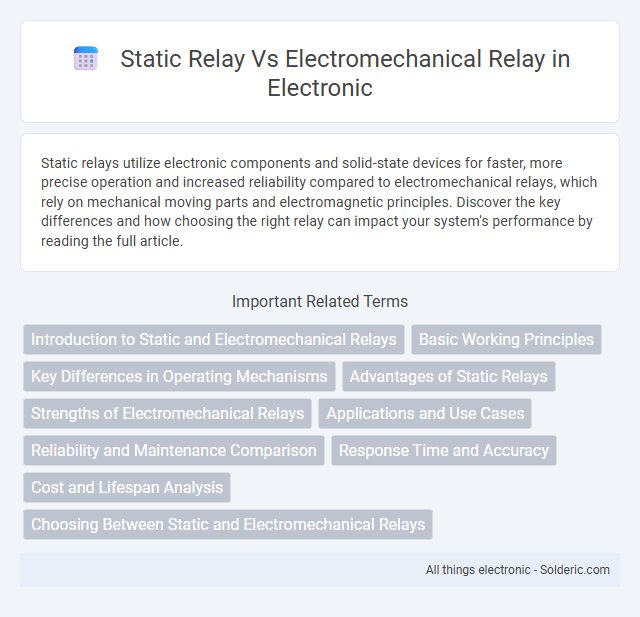Static relays utilize electronic components and solid-state devices for faster, more precise operation and increased reliability compared to electromechanical relays, which rely on mechanical moving parts and electromagnetic principles. Discover the key differences and how choosing the right relay can impact your system's performance by reading the full article.
Comparison Table
| Feature | Static Relay | Electromechanical Relay |
|---|---|---|
| Operation Principle | Solid-state electronic components | Mechanical moving parts |
| Response Time | Microseconds to milliseconds | 10 to 20 milliseconds |
| Durability | High, no mechanical wear | Lower, subject to mechanical fatigue |
| Size | Compact and lightweight | Bulky and heavy |
| Maintenance | Minimal, no moving parts | Frequent maintenance required |
| Contact Life | Long life, no mechanical contacts | Limited by physical contact wear |
| Cost | Higher initial cost | Lower initial cost |
| Noise | Silent operation | Audible clicking noise |
| Applications | Modern protection systems, fast switching | Legacy systems, simple control circuits |
Introduction to Static and Electromechanical Relays
Static relays utilize solid-state electronic components to detect electrical faults swiftly and accurately, offering faster response times and greater reliability compared to traditional electromechanical relays, which rely on moving mechanical parts and electromagnetic principles. Electromechanical relays, while robust and simple in design, often experience mechanical wear and slower operation that can impact your system's protective performance. Understanding these fundamental differences helps you choose the ideal relay type for effective electrical protection and system stability.
Basic Working Principles
Static relays operate using solid-state electronic components, detecting electrical faults by processing input signals through sensors and amplifiers to trigger protective actions swiftly and accurately. Electromechanical relays rely on mechanical movement generated by electromagnetic forces when current flows through a coil, physically opening or closing contacts to control circuits. Your choice between these relays depends on factors like response speed, accuracy, and durability in specific electrical protection applications.
Key Differences in Operating Mechanisms
Static relays operate using semiconductor components and electronic circuits, offering faster response times and higher accuracy compared to electromechanical relays, which rely on mechanical moving parts such as coils and armatures to open or close contacts. Your system benefits from static relays' enhanced durability and reduced maintenance requirements, as they lack physical wear components inherent in electromechanical designs. The key difference in operating mechanisms lies in electronic signal processing for static relays versus mechanical motion triggered by electromagnetic attraction in electromechanical relays.
Advantages of Static Relays
Static relays offer higher reliability and faster response times compared to electromechanical relays due to their solid-state components, which reduce mechanical wear and tear. They provide better accuracy, adjustable settings, and easier integration with digital control systems, enhancing your overall protection scheme. Static relays also consume less power and require lower maintenance, making them cost-effective and efficient for modern electrical applications.
Strengths of Electromechanical Relays
Electromechanical relays offer high reliability in switching heavy loads and provide physical isolation between control and power circuits, making them ideal for industrial applications. They excel in withstanding voltage surges and electrical noise, ensuring stable performance in harsh environments. Your systems benefit from their straightforward design and durability, which require minimal maintenance over long service periods.
Applications and Use Cases
Static relays excel in applications requiring high-speed switching, precise fault detection, and minimal maintenance, commonly found in modern power distribution, industrial automation, and telecommunications systems. Electromechanical relays are preferred in simpler, cost-sensitive environments such as basic control circuits, motor starters, and legacy electrical panels, where robustness and straightforward operation matter most. Your choice depends on system complexity, response time requirements, and maintenance capabilities.
Reliability and Maintenance Comparison
Static relays offer higher reliability due to their solid-state components, which are less prone to mechanical wear and environmental factors compared to electromechanical relays. Maintenance requirements for static relays are minimal since they lack moving parts, whereas electromechanical relays need regular inspection and calibration to prevent contact degradation and mechanical failure. Your choice between the two types should consider the long-term maintenance costs and operational reliability needed for your application.
Response Time and Accuracy
Static relays offer significantly faster response times, typically in milliseconds, due to their electronic components that process signals instantly. Electromechanical relays rely on physical moving parts, resulting in slower response times and potential mechanical wear that can reduce accuracy over time. Your choice of relay affects protection precision, with static relays providing more consistent and precise operation for sensitive and high-speed applications.
Cost and Lifespan Analysis
Static relays typically have a higher initial cost compared to electromechanical relays due to their advanced semiconductor components and digital circuitry. However, static relays offer a significantly longer lifespan, often exceeding 10-15 years, as they lack moving parts prone to mechanical wear and tear. Electromechanical relays, while more affordable upfront, usually have a shorter operational life of 3-7 years because of mechanical contact degradation and frequent maintenance requirements.
Choosing Between Static and Electromechanical Relays
Choosing between static and electromechanical relays depends on your specific application requirements such as switching speed, durability, and maintenance needs. Static relays offer faster response times, higher reliability, and longer lifespans due to the absence of moving parts, making them ideal for high-speed and high-frequency operations. Electromechanical relays, while slower and prone to mechanical wear, are often preferred for their simplicity, cost-effectiveness, and ability to handle high voltage and current loads in traditional power systems.
Static relay vs electromechanical relay Infographic

 solderic.com
solderic.com